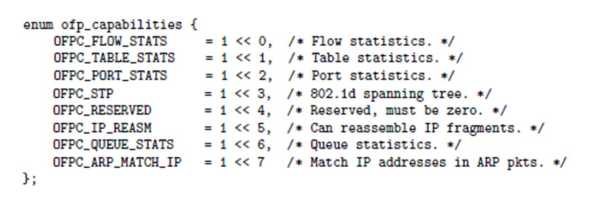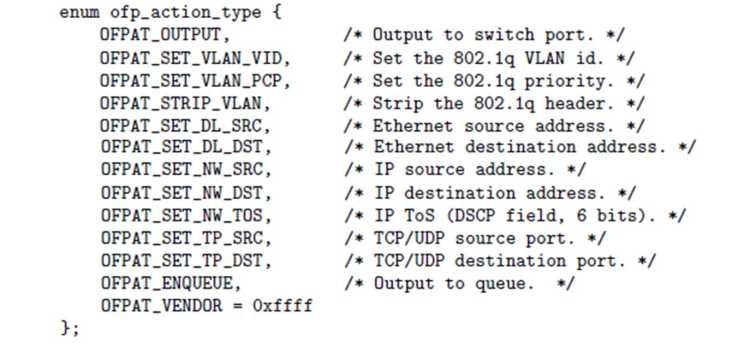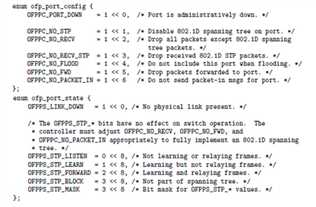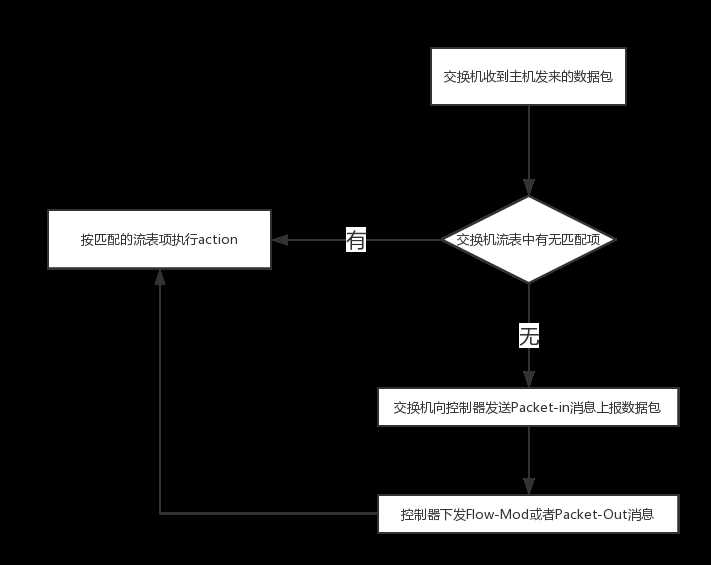标签:cap 种类型 err png igmp idle 大数据 .com ict

1. Hello
控制器与交互及互相发送 Hello 消息。Hello消息中只包含有OpenFlow Header,其中的 type 字段为 OFPT_HELLO,version 字段为发送方所支持的最高版本 OpenFlow 。这时候会出现两种情况:
如果双方 OpenFlow 版本可以兼容,则 OpenFlow 连接建立成功。
Q1:Hello 消息是使用什么协议传输?TCP?UDP?
Q2:所有的网络协议在升级的时候都必须向前兼容更低版本的协议?
2. Features Request
OpenFlow 连接建立之后,就像你刚到手一部新手机,你最想知道的就是手机的配置如何一样,控制器最需要获得交换机的特性信息,交换机的特性信息包括交换机的 ID(DPID),交换机缓冲区数量,交换机端口及端口属性等等。
控制器向交换机发送 Features Request 消息查询交换机特性,Features Request 消息只包含 OpenFlow Header,其中 type 字段为 OFPT_FEATURES_REQUEST。
3. Features Reply
交换机在收到控制器发出的 Features Request 消息后返回 Features Request 消息,Features 消息包括 OpenFlow Header 和 Features Reply Message。后者结构如下:
struct ofp_switch_features{
struct ofp_header header;
uint64_t datapath_id; /*唯一标识 id 号*/
uint32_t n_buffers; /*交缓冲区可以缓存的最大数据包个数*/
uint8_t n_tables; /*流表数量*/
uint8_t pad[3]; /*align to 64 bits*/
uint32_t capabilities; /*支持的特殊功能,具体见 ofp_capabilities*/
uint32_t actions; /*支持的动作,具体见 ofp_actions_type*/
struct ofp_phy_port ports[0]; /*物理端口描述列表,具体见 ofp_phy_port*/
};Q3:uint8_t pad[3] 这一字段的作用是什么?为了保证整个结构体长度是 64bits 的整数倍?
ofp_capabilities 结构如下:

ofp_actions_type 结构如下:

ofp_phy_port 结构如下:
struct ofp_phy_port{
uint16_t port_no; /*物理端口的编号*/
uint8_t hw_addr[OFP_EHT_ALEN]; /*MAC地址*/
char name[OFP_MAX_PORT_NAME_LEN]; /*端口的名称*/
uint32_t config; /*端口配置,见 ofp_port_config*/
uint32_t state; /*端口状态,见ofp_port_state*/
uint32_t curr; /*物理属性*/
uint32_t advertised; /*物理属性*/
uint32_t supported; /*物理属性*/
uint32_t peer; /*物理属性*/
};ofp_port_config 和 ofp_port_state 结构如下:

4. Set config
知道了交换机的特性之后就要配置交换机了。OpenFlow 交换机只有两个属性需要控制器配置:

5. Packet-in
有两种情况会触发交换机向控制器发送 Packet-in 消息:
struct ofp_packet_in {
struct ofp_header header;
uint32_t buffer_id; /*Packet-in消息所携带的数据包在交换机缓存区中的ID*/
uint16_t total_len; /*data字段的长度*/
uint16_t in_port; /*数据包进入交换机时的端口号*/
uint8_t reason; /*发送Packet-in消息的原因,具体见 ofp_packet_in_reason*/
uint8_t pad;
uint8_t data[0]; /*携带的数据包*/
};ofp_packet_in_reason 结构如下:
enum ofp_packet_in_reason {
OFPR_NO_MACTH /*没有匹配的条目*/
OFPR_ACTION /*action列表中包含转发给控制器的动作*/
};6. Flow-Mod / Packet-out
当控制器收到 Packet-in 消息时有两种响应的方式:
Flow-Mod
控制器收到 Packet‐in 消息后,可以发送 Flow‐Mod 消息向交换机写一个流表项。并
且将 Flow‐Mod 消息中的 buffer_id 字段设置为 Packet‐in 消息中的 buffer_id 值。从而
控制器向交换机写入了一条与数据包相关的流表项,并且指定该数据包按照此流表项的 action 列表处理。
Flow-Model 消息共有五种类型:
struct ofp_flow_mod {
struct ofp_header header;
struct ofp_match match; /*流表的匹配域*/
uint64_t cookie; /*流表项标识符*/
uint16_t command; /*可以是ADD,DELETE,DELETE-STRICT,MODIFY,MODIFY-STRICT*/
uint16_t idle_timeout; /*空闲超时时间*/
uint16_t hard_timeout; /*最大生存时间*/
uint16_t priority; /*优先级,优先级高的流表项优先匹配*/
uint32_t buffer_id; /*缓存区ID ,用于指定缓存区中的一个数据包按这个消息的action列表处理*/
uint16_t out_port; /*如果这条消息是用于删除流表则需要提供额外的匹配参数*/
uint16_t flags; /*标志位,可以用来指示流表删除后是否发送flow‐removed消息,添加流表时是否检查流表重复项,添加的流表项是否为应急流表项。*/
struct ofp_action_header actions[0]; /*action列表*/
};Packet-Out
并不是所有的数据包都需要 向交换机中添加一条流表项来匹配处理,网络中有些数据包出现的数量很少(如ARP、 IGMP等),没必要通过流表项来指定这一类数据包的处理方法。此时可以使用 Packet-Out 消息,高速交换机某一个数据包如何处理。
struct ofp_packet_out {
struct ofp_header header;
uint32_t buffer_id; /*交换机缓存区id,如果为-1则指定的为packet-out消息携带的data字段*/
uint16_t in_port; /*如果buffer_id为‐1,并且action列表中指定了Output=TABLE的动作,in_port将作为data段
数据包的额外匹配信息进行流表查询*/
uint16_t actions_len; /*action列表的长度,可以用来区分actions和data段*/
struct ofp_action_header actions[0]; /*动作列表*/
uint8_t data[0]; /*数据缓存区,可以存储一个以太网帧,可选*/
}Flow-Mod 是指定一类数据包的处理方法,而 Packet-Out 则是指定某一个数据包的处理方法。不仅如此,Packet-Out 消息还可以让交换机产生一个数据包并按照 action 列表处理。
基于 OpenFlow 的 SDN 工作流程,如下图:

标签:cap 种类型 err png igmp idle 大数据 .com ict
原文地址:https://www.cnblogs.com/multhree/p/9520859.html